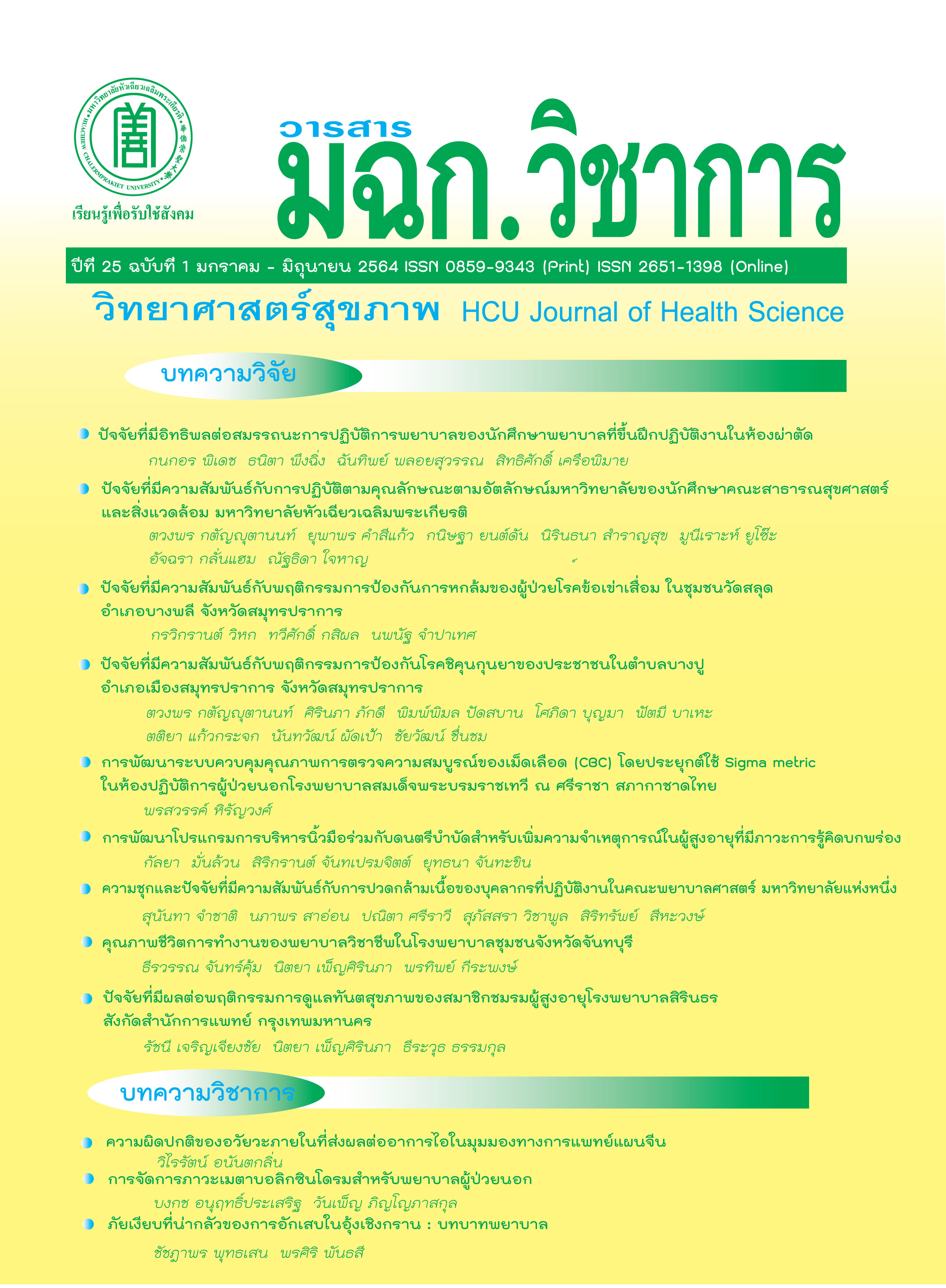Terrible Silent danger of Pelvic Inflammatory Disease: Nurse roles
บทบาทพยาบาล
Keywords:
Pelvic inflammatory disease, sexually transmitted disease, nurse rolesAbstract
Pelvic inflammatory disease resulted from infection of the lower genital area into the pelvic organs. There are causes and risk factors derived from inappropriate sexual behavior, sexual infections, hormonal changes and non-sterile procedures which affect complications and the quality of life of patients such as tubo-ovarain abscess, pelvic fascia, ectopic pregnancy or infertility. Even if the diagnosis and treatment are currently much more effective and receive rapid screening but there are some patients do not show symptoms in the early phase. These patients will undergo surgery urgently because are serious complications and life-threatening such as an infection into the blood stream, rupture of abscess in the fallopian tubes or ovaries and bleeding in the pelvic cavity leading to shock and death. Therefore, nurse is importance health personnel for preventing PID and its recurrence in women by providing health education regarding avoid causes and risk factors of PID and self-care of PID. If there are abnormal symptoms, should see a doctor soon for appropriate treatment immediately.
Downloads
References
Ross J, Guaschino J, Cusini M, Jensen J. 2017 European guideline for the management of pelvic inflammatory disease. Int J STD AIDS. 2018;29(2):108-14.
จีรพรรณ เลิศวงศ์สกุล, เจนจิต ฉายะจินดา, วิไลลักษณ์ เรืองรัตนตรัย. การพยาบาลผู้ป่วยโรคอักเสบ ติดเชื้อในอุ้งเชิงกราน. เวชบันทึกศิริราช. 2563;13(3):216-21.
Lewis J, Horner PJ, White PJ . Incidence of pelvic inflammatory disease associated with mycoplasma genitalium infection: Evidence synthesis of cohort study data. Clin Inf Dis. 2020;71(10):2719–22.
Das BB, Ronda J, Trent M. Pelvic inflammatory disease: Improving awareness, prevention, and treatment. Inf Drug Resist. 2016;9:191–7.
Sabb Gul BK, Albati ZA, Ismaeel Badr RR, Alfaraj ZM, Mohammed Z, Almatrafi AS, et al. Pelvic inflammatory disease. Egypt J Hosp Med. 2018;70(9):1464-7.
Oseni TIA, Odewale MA. Socioeconomic status of parents and the occurrence of pelvic inflammatory disease among undergraduates attending Irrua Specialist Teaching Hospital Irrua, Edo State, Nigeria. Niger Postgrad Med J. 2017;24(2):114-20.
Hubacher D. Intrauterine devices and infection: Review of the literature. Indian J Med Res. 2014;140(1):53–7.
Khan S, Ansari MA, Vasenwala SM, Mohsin Z. A community based study on pelvic inflammatory disease in postmenopausal females: Microbiological spectrum and socio-demographic correlates. J Clin Diagn Res. 2017;11(3):5-10.
Gondwe T, Ness R, Totten PA, Astete S, Tang G, Gold MA, et al. Novel bacterial vaginosis-associated organisms mediate the relationship between vaginal douching and pelvic inflammatory disease. Sex Transm Infect. 2020;96:439-44.
Fauna H, Abdul R, Dwi H, Rika Y. Antibiotic prophylactics on curettage for preventing pelvic inflammatory disease events: Is it necessary?. Asian J Pharm Clin Res. 2018;11(11):267-69.
Lee L. Pelvic inflammatory disease. JAAPA. 2017;30(2):47-56.
Oli MK, Thapa KB, Paudel RC. Pelvic inflammatory disease among the women attended in Rapti sub-regional hospital, Nepal. Asian Res J Gynaecol and Obstet. 2020;14(2):17-23
Kim HY, Yang JI, Moon C, Comparison of severe pelvic inflammatory disease, pyosalpinx and tubo-ovarian abscess. J Obstet Gynaecol Res. 2015;41(5): 742-6.
Munro K, Gharaibeh A, Nagabushanam S, Martin C. Diagnosis and management of tubo-ovarian abscesses. Obstet Gynaecol. 2018;20(1):11-9.
Coremans L, Clerck FD. Fitz-Hugh-Curtis syndrome associated with tuberculous salpingitis and peritonitis: a case presentation and review of literature. BMC Gastroenterol. 2018;20:1-5.
Ekabe CJ. Kehbila J, Njim T, Kadia BM, Tendonge CN, and Monekosso GL. Chlamydia Trachomatis-induced Fitz-Hugh–Curtis syndrome: a A case report. BMC Res Notes. 2017;10(10):1-4.
Huang CC, Huang CC, Lin SY, Chang CY, Lin WC, Chung CH. Association of pelvic inflammatory disease (PID) with ectopic pregnancy and preterm labor in Taiwan: A nationwide population-based retrospective cohort study. PLoS One. 2019;14(8):1-13.
Heijer CD, Hoebe CJ, Driessen JH, Wolffs P, Broek IV, Hoenderboom BM, et al. Chlamydia trachomatis and the risk of pelvic inflammatory disease, ectopic pregnancy, and pemale infertility: A retrospective cohort study among primary care patients. Clin Infect Dis. 2019;69(9):1517–25.
Shew Q, Tang L. Analysis on clinical effects of humanistic nursing care on chronic pelvic inflammatory disease. Indian J Pharm Sci. 2020;8:114-8.
Brunham RC, Gottlieb SL, Paavonen J. Pelvic inflammatory disease. N Engl J Med. 2015; 372(21):2039–48.
Curry A, William T, Penny ML. Pelvic inflammatory disease: diagnosis, management, and prevention. Am Fam Physician. 2019;100(6):357-64.
Park ST, Lee SW, Kim MJ, Kang YM, Moon HM, Rhim CC. Clinical characteristics of genital chlamydia infection in pelvic inflammatory disease. BMC Women Health. 2017;17(5):1-7.
Wiesenfeld HC, Meyn LA, Darville T, Macio IS, Hillier SL. A randomized controlled trial of ceftriaxone and doxycycline, with or without metronidazole, for the treatment of acute pelvic inflammatory disease. Clin Infect Dis. 2021;72(7):1181-9.
Wang B. Progress in nursing methods for chronic pelvic inflammatory disease. Infect Int. 2016;5(2): 31-5.
Trent M, Perin J, Gaydos CA, Anders J, Chung S, Saeed LT, et al. Efficacy of a technology enhanced community health nursing intervention vs standard of care for female adolescents and young adults with pelvic inflammatory disease a randomized clinical trial. JAMA Netw. 2019;2(8):
-12.
Hay PE, Kerry SE , Normansell R, Horner PJ, Reid F, Kerry SM, et al. Which sexually active young female students are most at risk if pelvic inflammatory disease? A prospective study. Sex Transm Infect. 2016;92:63-66.
Downloads
Published
How to Cite
Issue
Section
License
บทความที่ได้รับการตีพิมพ์เป็นลิขสิทธิ์ของวารสารวิทยาศาสตร์สุขภาพและสุขภาวะ
ข้อความที่ปรากฏในบทความแต่ละเรื่องในวารสารวิชาการเล่มนี้เป็นความคิดเห็นส่วนตัวของผู้เขียนแต่ละท่านไม่เกี่ยวข้องกับมหาวิทยาลัยหัวเฉียวเฉลิมพระเกียรติ และคณาจารย์ท่านอื่นๆในมหาวิทยาลัยฯ แต่อย่างใด ความรับผิดชอบองค์ประกอบทั้งหมดของบทความแต่ละเรื่องเป็นของผู้เขียนแต่ละท่าน หากมีความผิดพลาดใดๆ ผู้เขียนแต่ละท่านจะรับผิดชอบบทความของตนเองแต่ผู้เดียว




